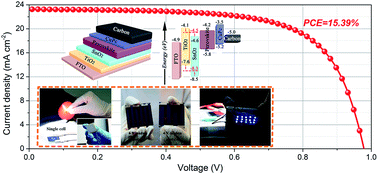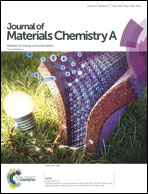15% efficient carbon based planar-heterojunction perovskite solar cells using a TiO2/SnO2 bilayer as the electron transport layer†
Abstract
Perovskite solar cells (PSCs) are one of the most promising lab-scale technologies to deliver inexpensive solar electricity. Low-temperature printable carbon counter electrode based planar-heterojunction PSCs are particularly suitable for future large-scale manufacturing, but suffer from an inferior efficiency. Here, we demonstrate a TiO2/SnO2 bilayer as the electron transport layer (ETL) for carbon counter electrode based planar-heterojunction PSCs together with micromolecule Cu-phthalocyanine (CuPc) as the hole transport layer (HTL), yielding a high power conversion efficiency of 15.39% and an excellent stability over 1200 h. The improved performances are attributed to a better energy level transition, a suppressed electron–hole recombination, and a wider depletion region of the TiO2/SnO2 bilayer. Our work represents a great advancement in the fabrication and popularization of carbon counter electrode based PSCs. More importantly, the whole devices are processed at a temperature below 200 °C, providing potential application of PSCs in monolithic tandem devices and paving the way for the development of carbon based flexible PSCs.



 Please wait while we load your content...
Please wait while we load your content...